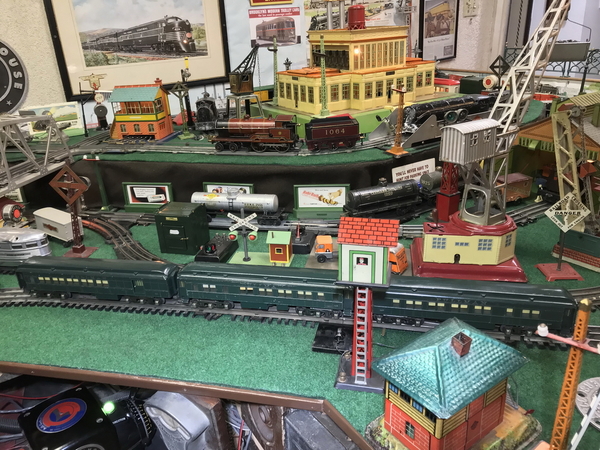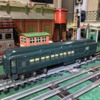I recently acquired a three-car set of American Flyer prewar O gauge diecast passenger cars, a 521 Club Car and a pair of 524 Pullmans. From the Greenberg Flyer Prewar O Gauge book by Schuweiler these were produced 1939-41 as the start of the new 3/16" scale line of rolling stock embarked upon by new owners A.C. Gilbert Co. After World War II this product line would be retooled as S gauge. So basically these cars are S gauge bodies on O gauge trucks. Despite their relatively compact size (12" long), these things are heavy! 1 pound, 14 oz. as compared to a much larger Lionel Madison heavyweight passenger car at 1 pound 10 oz. They're beautifully proportioned and have a unique look to them. They have spring-loaded opening vestibule doors, and neat-looking window shade inserts. They also have an interesting coupler system which looks really bulky when you see one exposed, but the cars couple together quite closely making for a good looking train.
I put them on the layout and tried pulling them with various engines, most of which just spun their wheels. A Lionel postwar 736 Berkshire with Magnetraction would do it, but just barely. With their relatively small wheels and slightly narrower wheel spacing, they're not exactly "free rolling". Now I'm curious to see what Flyer engines of the same period will actually pull these things! In the same era Flyer also produced a series of sheet metal passenger cars, they also had 6-wheel trucks and similar proportions. That series featured a nice-looking No. 497 open platform observation car.
The cars are in nice condition, although there are two journal box covers missing; does anyone know if these were common to other Flyer cars (e.g. postwar S gauge) ? Also on the Club Car, one of the baggage doors has fallen inside. Turning the car over, the underframe and body are not joined together with screws, but rather with peened-over studs, so taking the body off to fix the door looks to be a bit more involved.































